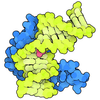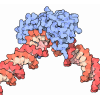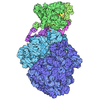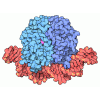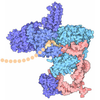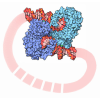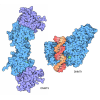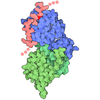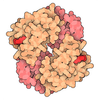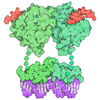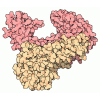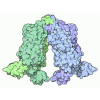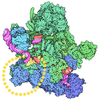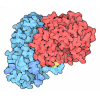+ データを開く
データを開く
- 基本情報
基本情報
| 登録情報 | データベース: PDB / ID: 6o6c | |||||||||
|---|---|---|---|---|---|---|---|---|---|---|
| タイトル | RNA polymerase II elongation complex arrested at a CPD lesion | |||||||||
 要素 要素 |
| |||||||||
 キーワード キーワード | TRANSFERASE/DNA/RNA / RNA polymerase / CPD / elongation complex / streptavidin grids / transcription / transferase-DNA-RNA complex | |||||||||
| 機能・相同性 |  機能・相同性情報 機能・相同性情報RNA Polymerase I Transcription Initiation / Processing of Capped Intron-Containing Pre-mRNA / RNA Polymerase III Transcription Initiation From Type 2 Promoter / RNA Pol II CTD phosphorylation and interaction with CE / Formation of the Early Elongation Complex / mRNA Capping / RNA polymerase II transcribes snRNA genes / termination of RNA polymerase II transcription / TP53 Regulates Transcription of DNA Repair Genes / RNA Polymerase II Promoter Escape ...RNA Polymerase I Transcription Initiation / Processing of Capped Intron-Containing Pre-mRNA / RNA Polymerase III Transcription Initiation From Type 2 Promoter / RNA Pol II CTD phosphorylation and interaction with CE / Formation of the Early Elongation Complex / mRNA Capping / RNA polymerase II transcribes snRNA genes / termination of RNA polymerase II transcription / TP53 Regulates Transcription of DNA Repair Genes / RNA Polymerase II Promoter Escape / RNA Polymerase II Transcription Pre-Initiation And Promoter Opening / RNA Polymerase II Transcription Initiation / RNA Polymerase II Transcription Initiation And Promoter Clearance / termination of RNA polymerase III transcription / RNA Polymerase II Pre-transcription Events / RNA-templated transcription / Formation of TC-NER Pre-Incision Complex / transcription initiation at RNA polymerase III promoter / RNA Polymerase I Promoter Escape / termination of RNA polymerase I transcription / Gap-filling DNA repair synthesis and ligation in TC-NER / transcription initiation at RNA polymerase I promoter / nucleolar large rRNA transcription by RNA polymerase I / Estrogen-dependent gene expression / maintenance of transcriptional fidelity during transcription elongation by RNA polymerase II / transcription by RNA polymerase III / Dual incision in TC-NER / translesion synthesis / RNA polymerase I complex / transcription elongation by RNA polymerase I / RNA polymerase III complex / RNA polymerase II, core complex / tRNA transcription by RNA polymerase III / transcription by RNA polymerase I / transcription-coupled nucleotide-excision repair / transcription initiation at RNA polymerase II promoter / transcription elongation by RNA polymerase II / ribonucleoside binding / DNA-directed RNA polymerase / cytoplasmic stress granule / DNA-directed RNA polymerase activity / peroxisome / ribosome biogenesis / nucleic acid binding / transcription by RNA polymerase II / protein dimerization activity / mRNA binding / nucleolus / mitochondrion / DNA binding / zinc ion binding / nucleoplasm / metal ion binding / nucleus / cytoplasm 類似検索 - 分子機能 | |||||||||
| 生物種 |  | |||||||||
| 手法 | 電子顕微鏡法 / 単粒子再構成法 / クライオ電子顕微鏡法 / 解像度: 3.1 Å | |||||||||
 データ登録者 データ登録者 | Lahiri, I. / Leshziner, A.E. | |||||||||
| 資金援助 |  米国, 2件 米国, 2件
| |||||||||
 引用 引用 |  ジャーナル: J Struct Biol / 年: 2019 ジャーナル: J Struct Biol / 年: 2019タイトル: 3.1 Å structure of yeast RNA polymerase II elongation complex stalled at a cyclobutane pyrimidine dimer lesion solved using streptavidin affinity grids. 著者: Indrajit Lahiri / Jun Xu / Bong Gyoon Han / Juntaek Oh / Dong Wang / Frank DiMaio / Andres E Leschziner /  要旨: Despite significant advances in all aspects of single particle cryo-electron microscopy (cryo-EM), specimen preparation still remains a challenge. During sample preparation, macromolecules interact ...Despite significant advances in all aspects of single particle cryo-electron microscopy (cryo-EM), specimen preparation still remains a challenge. During sample preparation, macromolecules interact with the air-water interface, which often leads to detrimental effects such as denaturation or adoption of preferred orientations, ultimately hindering structure determination. Randomly biotinylating the protein of interest (for example, at its primary amines) and then tethering it to a cryo-EM grid coated with two-dimensional crystals of streptavidin (acting as an affinity surface) can prevent the protein from interacting with the air-water interface. Recently, this approach was successfully used to solve a high-resolution structure of a test sample, a bacterial ribosome. However, whether this method can be used for samples where interaction with the air-water interface has been shown to be problematic remains to be determined. Here we report a 3.1 Å structure of an RNA polymerase II elongation complex stalled at a cyclobutane pyrimidine dimer lesion (Pol II EC(CPD)) solved using streptavidin grids. Our previous attempt to solve this structure using conventional sample preparation methods resulted in a poor quality cryo-EM map due to Pol II EC(CPD)'s adopting a strong preferred orientation. Imaging the same sample on streptavidin grids improved the angular distribution of its view, resulting in a high-resolution structure. This work shows that streptavidin affinity grids can be used to address known challenges posed by the interaction with the air-water interface. | |||||||||
| 履歴 |
|
- 構造の表示
構造の表示
| ムービー |
 ムービービューア ムービービューア |
|---|---|
| 構造ビューア | 分子:  Molmil Molmil Jmol/JSmol Jmol/JSmol |
- ダウンロードとリンク
ダウンロードとリンク
- ダウンロード
ダウンロード
| PDBx/mmCIF形式 |  6o6c.cif.gz 6o6c.cif.gz | 774.9 KB | 表示 |  PDBx/mmCIF形式 PDBx/mmCIF形式 |
|---|---|---|---|---|
| PDB形式 |  pdb6o6c.ent.gz pdb6o6c.ent.gz | 611.2 KB | 表示 |  PDB形式 PDB形式 |
| PDBx/mmJSON形式 |  6o6c.json.gz 6o6c.json.gz | ツリー表示 |  PDBx/mmJSON形式 PDBx/mmJSON形式 | |
| その他 |  その他のダウンロード その他のダウンロード |
-検証レポート
| 文書・要旨 |  6o6c_validation.pdf.gz 6o6c_validation.pdf.gz | 910 KB | 表示 |  wwPDB検証レポート wwPDB検証レポート |
|---|---|---|---|---|
| 文書・詳細版 |  6o6c_full_validation.pdf.gz 6o6c_full_validation.pdf.gz | 936 KB | 表示 | |
| XML形式データ |  6o6c_validation.xml.gz 6o6c_validation.xml.gz | 92.9 KB | 表示 | |
| CIF形式データ |  6o6c_validation.cif.gz 6o6c_validation.cif.gz | 145 KB | 表示 | |
| アーカイブディレクトリ |  https://data.pdbj.org/pub/pdb/validation_reports/o6/6o6c https://data.pdbj.org/pub/pdb/validation_reports/o6/6o6c ftp://data.pdbj.org/pub/pdb/validation_reports/o6/6o6c ftp://data.pdbj.org/pub/pdb/validation_reports/o6/6o6c | HTTPS FTP |
-関連構造データ
- リンク
リンク
- 集合体
集合体
| 登録構造単位 | 
|
|---|---|
| 1 |
|
- 要素
要素
-DNA-directed RNA polymerase II subunit ... , 5種, 5分子 ABCGI
| #1: タンパク質 | 分子量: 191821.578 Da / 分子数: 1 / 由来タイプ: 天然 / 由来: (天然)  |
|---|---|
| #2: タンパク質 | 分子量: 138937.297 Da / 分子数: 1 / 由来タイプ: 天然 / 由来: (天然)  |
| #3: タンパク質 | 分子量: 35330.457 Da / 分子数: 1 / 由来タイプ: 天然 / 由来: (天然)  |
| #7: タンパク質 | 分子量: 14308.161 Da / 分子数: 1 / 由来タイプ: 天然 / 由来: (天然)  |
| #9: タンパク質 | 分子量: 13633.493 Da / 分子数: 1 / 由来タイプ: 天然 / 由来: (天然)  |
-DNA-directed RNA polymerases I, II, and III subunit ... , 5種, 5分子 DEFHJ
| #4: タンパク質 | 分子量: 25117.094 Da / 分子数: 1 / 由来タイプ: 天然 / 由来: (天然)  |
|---|---|
| #5: タンパク質 | 分子量: 17931.834 Da / 分子数: 1 / 由来タイプ: 天然 / 由来: (天然)  |
| #6: タンパク質 | 分子量: 16525.363 Da / 分子数: 1 / 由来タイプ: 天然 / 由来: (天然)  |
| #8: タンパク質 | 分子量: 8290.732 Da / 分子数: 1 / 由来タイプ: 天然 / 由来: (天然)  |
| #10: タンパク質 | 分子量: 7729.969 Da / 分子数: 1 / 由来タイプ: 天然 / 由来: (天然)  |
-RNA鎖 , 1種, 1分子 K
| #11: RNA鎖 | 分子量: 2934.831 Da / 分子数: 1 / 由来タイプ: 合成 / 由来: (合成)  |
|---|
-DNA鎖 , 2種, 2分子 LM
| #12: DNA鎖 | 分子量: 5046.293 Da / 分子数: 1 / 由来タイプ: 合成 / 由来: (合成)  |
|---|---|
| #13: DNA鎖 | 分子量: 8376.361 Da / 分子数: 1 / 由来タイプ: 合成 / 由来: (合成)  |
-非ポリマー , 2種, 9分子 


| #14: 化合物 | ChemComp-ZN / #15: 化合物 | ChemComp-MG / | |
|---|
-実験情報
-実験
| 実験 | 手法: 電子顕微鏡法 |
|---|---|
| EM実験 | 試料の集合状態: PARTICLE / 3次元再構成法: 単粒子再構成法 |
- 試料調製
試料調製
| 構成要素 | 名称: RNA polymerase II elongation complex stalled at a CPD lesion タイプ: COMPLEX / Entity ID: #1-#13 / 由来: NATURAL |
|---|---|
| 分子量 | 実験値: NO |
| 由来(天然) | 生物種:  |
| 緩衝液 | pH: 7.5 |
| 試料 | 包埋: NO / シャドウイング: NO / 染色: NO / 凍結: YES |
| 試料支持 | 詳細: The grids had a monolayer of streptavidin crystals on them. グリッドの材料: GOLD / グリッドのサイズ: 300 divisions/in. / グリッドのタイプ: Quantifoil R2/2 |
| 急速凍結 | 装置: FEI VITROBOT MARK IV / 凍結剤: ETHANE / 湿度: 100 % / 凍結前の試料温度: 293.15 K 詳細: The sample was manually wicked from the grid. 1.2 uL sample buffer was then applied to the streptavidin side. The grid was then blotted. |
- 電子顕微鏡撮影
電子顕微鏡撮影
| 実験機器 | 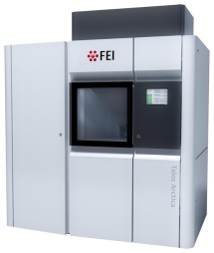 モデル: Talos Arctica / 画像提供: FEI Company |
|---|---|
| 顕微鏡 | モデル: FEI TALOS ARCTICA |
| 電子銃 | 電子線源:  FIELD EMISSION GUN / 加速電圧: 200 kV / 照射モード: OTHER FIELD EMISSION GUN / 加速電圧: 200 kV / 照射モード: OTHER |
| 電子レンズ | モード: BRIGHT FIELD / Cs: 2.7 mm |
| 撮影 | 平均露光時間: 6 sec. / 電子線照射量: 51.7 e/Å2 / 検出モード: COUNTING フィルム・検出器のモデル: GATAN K2 SUMMIT (4k x 4k) 撮影したグリッド数: 1 |
- 解析
解析
| EMソフトウェア |
| ||||||||||||||||||||||||
|---|---|---|---|---|---|---|---|---|---|---|---|---|---|---|---|---|---|---|---|---|---|---|---|---|---|
| CTF補正 | タイプ: PHASE FLIPPING AND AMPLITUDE CORRECTION | ||||||||||||||||||||||||
| 対称性 | 点対称性: C1 (非対称) | ||||||||||||||||||||||||
| 3次元再構成 | 解像度: 3.1 Å / 解像度の算出法: FSC 0.143 CUT-OFF / 粒子像の数: 61654 / アルゴリズム: FOURIER SPACE / 対称性のタイプ: POINT | ||||||||||||||||||||||||
| 原子モデル構築 | プロトコル: FLEXIBLE FIT / 空間: REAL |
 ムービー
ムービー コントローラー
コントローラー



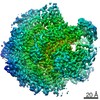
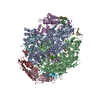






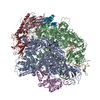


 PDBj
PDBj
